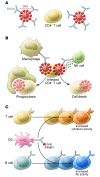Towards HIV-1 remission: potential roles for broadly neutralizing antibodies
- PMID: 26752643
- PMCID: PMC4731188
- DOI: 10.1172/JCI80561
Towards HIV-1 remission: potential roles for broadly neutralizing antibodies
Abstract
Current antiretroviral drug therapies do not cure HIV-1 because they do not eliminate a pool of long-lived cells harboring immunologically silent but replication-competent proviruses - termed the latent reservoir. Eliminating this reservoir and stimulating the immune response to control infection in the absence of therapy remain important but unsolved goals of HIV-1 cure research. Recently discovered broadly neutralizing antibodies (bNAbs) exhibit remarkable breadth and potency in their ability to neutralize HIV-1 in vitro, and recent studies have demonstrated new therapeutic applications for passively administered bNAbs in vivo. This Review discusses the roles bNAbs might play in HIV-1 treatment regimens, including prevention, therapy, and cure.
Figures


References
Publication types
MeSH terms
Substances
Grants and funding
LinkOut - more resources
Full Text Sources
Other Literature Sources
Medical

